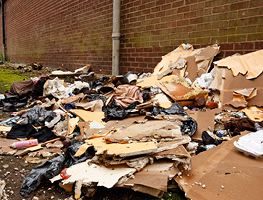Table of Contents:
With an increased focus on ensuring building safety, many landlords are now looking to decommission refuse chutes, improving neighbourhood quality and recycling rates through the implementation of more effective and sustainable waste management solutions.
Among the chief concerns with bin chutes are the characteristic, undesirable odour of decomposing food, which can constitute a serious health hazard for residents, and increased fire safety risks through poor maintenance and a build-up of combustible materials. In addition, the areas containing bin chutes can encourage anti-social behaviour, such as drug use and improper bulk-waste disposal.
Modern Waste Management Requirements
High-rise construction began to develop quickly in the UK during the postwar era, regarded as a quick solution to the presence of crumbling, unsanitary 19th century buildings that had been degraded during WW2. Refuse chutes, meanwhile, developed concurrently as a means of convenient residential waste disposal. However, the solution of wall-built waste disposal tunnels suited a time in UK history when households produced significantly less volumes of waste in much lighter loads.
Modern lifestyles have ultimately contributed greatly to a substantial increase in the household waste volumes and the adoption of larger refuse sacks. As a result, the issue now exists where bin chutes are too small to cope with modern waste requirements, frequently becoming blocked as residents improperly use them. For landlords and contractors, this can be a costly exercise, especially if it becomes a regular occurrence.
With many brands continuing to deliberately market products as disposable, there also exists a tendency for refuse chutes to discourage good recycling practice, as there is simply a lack of incentive for residents to segregate their recycling when it’s far easier to dispose of their waste in one refuse sack. While some modern bin chute systems do enable recycling, retrofitting this technology for older properties is expensive and can still incur the same issues, with their incorporation into new developments likewise a costly expense.
Case Studies
With Greater London the most urbanised area in the UK, much of the capital’s residential population is considered high-density, with high-rise buildings a common feature of the urban landscape. With most ‘tower blocks’ constructed between the 1950s and 70s, refuse chutes remain a common feature of waste management infrastructure in these buildings. However, in response to the Mayor of London’s 2030 target to recycle 65% of London’s municipal waste, recent efforts across the London Boroughs suggests an increased awareness of the benefits of decommissioning bin chutes, particularly in regard to developing cleaner and safer neighbourhoods.
London Borough of Hounslow
- Following recommendations by the London Fire Brigade (LFB), Hounslow Council were the first of the London Boroughs to engage in decommissioning the refuse chutes, chute rooms and internal refuse stores in their high-rise buildings. Beginning with a pilot project on the Brentford Towers Estate, a positive consultation with residents was followed by the installation of metroSTOR bin housings, forming waste and recycling hubs in accessible locations outside each tower block.
- With the project completed and chutes decommissioned in March 2021, successful results were seen within only 3 months. Residents acknowledged the visual improvement of the estate and its positive impact on the local community, with recycling volumes increasing significantly.
London Borough of Hackney
- In 2016, Hackney Council spent £75,000 on outside contractors unblocking 225 chutes. As a result, the council began investing in better waste and recycling facilities to increase recycling rates, reduce fire risks and improve the appearance of the estates across the borough. Following the closure of bin chutes and the installation of 57 bin stores across 7 estates during the spring and summer of 2020, Hackney Council reported a recycling rates increase of 2.5% and a waste tonnage reduction 7.2% after only 4 months of these measures being implemented
London Borough of Tower Hamlets
- One of the most densely populated areas in England, Tower Hamlets had one of the lowest recycling rates of all the London Boroughs in the Recycling Scorecard 2023, with bin chutes identified as one key issue in this. In response, Tower Hamlets Community Housing (TCHC) worked with metroSTOR to implement new bin houses at one of their high-rise blocks, Winterton House, replacing the current bin chutes.
- TCHC hopes that the success of the bin housings will enable further opportunities to integrate the units out across more of their neighbourhoods across the borough.
Alternative Solutions to Refuse Chutes
Offering a safer, more effective alternative to bin chutes that can be installed in convenient locations close to surrounding buildings, metroSTOR provides a range of bin enclosures that provide secure, future-proof waste storage solutions for use by modern communities, enabling landlords with great opportunities to drive real change and reduce costs within communities for a modest investment.
Secured externally at a safe distance from surrounding buildings, these waste & recycling systems provide distinct advantages over bin chutes, easily accommodating larger refuse sacks; eliminating the risk of chute blockages, and helping to reduce associated fire risks. To help increase recycling rates among residents, clearly-designated bin apertures enable the easy disposal of separated refuse and recycling.










